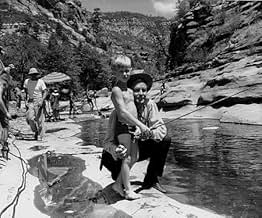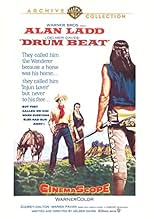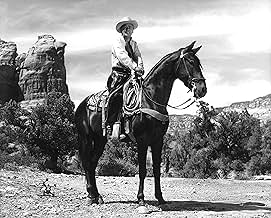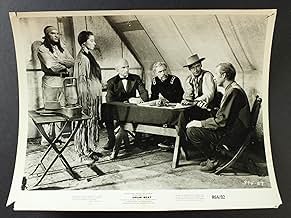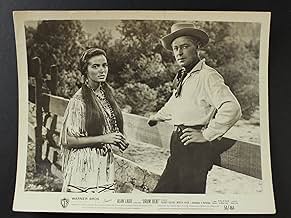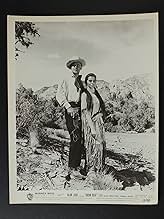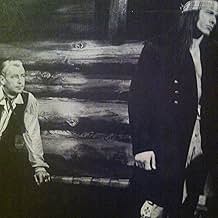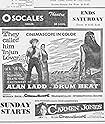En 1872, el luchador indio Johnny MacKay es nombrado comisionado de paz para el territorio de California y Oregón, pero se enfrenta a una dura oposición de los Modocs renegados liderados por... Leer todoEn 1872, el luchador indio Johnny MacKay es nombrado comisionado de paz para el territorio de California y Oregón, pero se enfrenta a una dura oposición de los Modocs renegados liderados por su jefe, el Capitán Jack.En 1872, el luchador indio Johnny MacKay es nombrado comisionado de paz para el territorio de California y Oregón, pero se enfrenta a una dura oposición de los Modocs renegados liderados por su jefe, el Capitán Jack.
- Dirección
- Guionista
- Elenco
- Modoc Jim
- (as Frank de Kova)
- Capt. Alonzo Clark
- (as George Lewis)
- Dirección
- Guionista
- Todo el elenco y el equipo
- Producción, taquilla y más en IMDbPro
Opiniones destacadas
The history may be real but it's told from one side of the conflict. This is an old fashion western in more than one way. It definitely has the scenery. Most white folks starting with MacKay are simply trying to keep the peace. The Indians are the trouble makers along with some white settlers. It's an early role for Bronson and he does some fine red-face acting. Alan Ladd is doing very blend acting. It's probably deliberate to give this character the persona of a peace giver. It may be propaganda but it works for the audience of its day. The American government only wants to help the red savage and some just refuse to be civilized.
Alan Ladd is Indian fighter Johnny Mackay, who is ordered by President Ulysses Grant (Hayden Rorke) to negotiate with the Modoc Indians in an attempt to avert war...
Utterly frustrating! One of the most attractive looking Westerns of the fifties, Daves' movie doesn't quite have the courage of its convictions. The core basis of the film is sound, though as we are told from the off, it features fictionalised enhancements to further dramatic impact. Snatching from a little known part of the Indian Wars from 1872/3 (to be applauded), that of the Modoc Uprising, film is set in 1869 around the Oregon-California border. Plot and story are put in place neatly, where the characters are interesting, the back drop of various Arizona locations is simply in "scope" gorgeous, and the narrative promises some boldness as the first person killed is an innocent woman and the white man protagonists are fuelled by anger and hatred. But...
Unfortunately with a running time of one hour and fifty minutes, many passages of chatter never really expand the characters. Something which is not usually applicable to Delmer Daves when he was on form. We should be getting high grade dramatic worth from the principle players, their conversations should ping with emotion and depth, after being set up as people with voices to be heard, we never get a real grasp of Mackay's inner conflict, or Captain Jack's (Bronson) staunch loyalty to his cause, or even the depth and reasoning of Bill Satterwhite's (Keith) hatred. While there is, as the historians will tell you, a severe dilution of the story to suit the white man's cause. It's hard to believe this is the same director of Broken Arrow from four years earlier! But then Daves wasn't writing the screenplay....
Maybe Daves felt he needed to better the screenplay for Broken Arrow? To show he could put down on the page some "liberal" quality as well as directing? He would prove post Drum Beat that he could "co-write" great Western screenplays (Jubal/White Feather/The Last Wagon), but here on his own he falls short. Not only does it skulk in the shadow of Broken Arrow, it also pales into insignificance to Anthony Mann's brilliant Devil's Doorway, which was also from 1950. You can feel Daves striving for relevance in the mid fifties, but he is trumped by narrative zest elsewhere, a shame since the acting performances and production quality make Drum Beat very watchable.
Visually it's superb, Sedona's various natural beauties are excellently captured by Peverell Marley (The Left Handed Gun/Westbound), while Daves proves adept at utilising the landscapes as part of his action sequences (check out the red rock rifle engagement scene). Young's score is a goodie, blending bombastic beats with ballad strains, and the Warnercolor is gorgeous, one of the better Warnercolor productions that I have seen. Acting wise it's Bronson's movie, physically perfect and featuring a shifty aggressive ebullience that's most appealing. Ladd scores well, too, nicely underplayed at the critical moments, Keith has a thespian quality that suits the role of an Indian hating aggressor, and Elisha Cook provides weasel smarts that make us yearn for his part to have been bigger.
Some have questioned why this isn't better known or worthy of a widespread home format release? The answer is that simply it has more style than substance, and Daves, as much as us Western fans love him, is to blame from a writing perspective. Visually and aurally the film ranks a comfortable 9/10. As a whole, sadly, it rounds out as 6.5/10.
Also, for this Bronson fan, that jail cell ending may well be the high point of his acting career. He shows more unforced good humor and naturalness there than any scene I've seen him in. In fact, he easily steals the movie from the rest of the cast, positioning himself as a real Hollywood comer.
This is an A-production from Warner Bros. For example, scope out the well stocked cavalry troop. No corner-cutting there. Then too, lavish use is made of Sedona's familiar red rock locations adding real scenic value. Also, there's a much larger than usual supporting cast of familiar faces, even down to bit parts. Producers Daves and Ladd (uncredited) do a bang-up job assembling the many components.
Surprisingly, for plot developments, the Indians actually get to win a battle and rejoice on- screen. However, the film's impact is damaged by being over-long, probably to accommodate a romantic interest to broaden audience appeal. Then too, Ladd, the actor, appears not nearly as interested in the film as Ladd, the co-producer. Frankly, he looks glum throughout the nearly two-hour running time, and I don't think it's from under-playing the part. Plus having him over-power the muscular, extremely fit looking Bronson is quite a stretch.
Despite these several drawbacks, it's still a good scenic, action flick, the first of director Daves' series of superior Westerns.
For the first time an American general was killed during the wars against the Indian tribes. The little known Modoc war was another of those lesser known conflicts as action against the Sioux on the Great Plains and the Apache in the Arizona desert got far more attention.
The Modocs were moved from a reservation in northern California to one in Oregon to share with the Klamath, a tribe that had a long feuding history with the Modoc. That was the immediate cause of the war. It was kept going by one of the Modoc's more charismatic leaders, a chief named Captain Jack.
On April 11, 1873, General E.R.S. Canby among other peace commissioners who were sitting in council with Captain Jack and the other chiefs were suddenly shot and killed, in fact Captain Jack personally did shoot General Canby. Charles Bronson in his very first film with that name having dropped his real birth last name of Buckinsky plays Captain Jack. Warner Anderson plays the feckless and luckless Canby.
The horror of that incident aroused some bad public opinion against the Modocs, not to dissimilar against to what was aroused against the Japanese after Pearl Harbor and Islamist extremists after the World Trade Center attack albeit on a much smaller scale. It certainly shifted priorities for a while in the War Department from the Sioux and the Apache.
Alan Ladd plays a real frontier figure named Johnny MacKay who as the film has him was a civilian scout employed by the army to find Captain Jack. His role in real life was not at the center stage of the film, but he did play a part in the Modoc Wars. And he was not among the surviving peace commissioners he wasn't at the meeting when the assassinations happened.
For all its inaccuracies Drum Beat is the only film I know to deal with this incident that shocked a nation during The Gilded Age.
The film begins with Alan Ladd being summoned to the White House to talk with President Grant. It seems that Ladd was called because he is a famed 'Indian fighter' and knows a lot about the recent uprisings among the Modoc Indians in the Washington/Oregon area (though the film sure didn't look that that part of the country to me). Ladd is given a commission as a Peace Commissioner--to pacify the problems, not just go in and kill everyone!
As Peace Commissioner, Ladd is in a bind. Some settlers and a cavalry officer and his wife have been murdered. The settlers are calling for action, but Ladd can't just start killing Indians without knowing exactly who was at fault. Ladd's job sure looks like a tough one.
When you see Captain Jack (not the pirate but the leader of these Indians), you will not be surprised that he's not played by a real American-Indian--this was very typical for the time period. Heck, the 1950s saw the likes of Rock Hudson(!), Jeff Chandler and other non-natives playing Indians. In this film, Charles Bronson (!!) plays the renegade Indian warrior--the same man of Lithuanian ancestry who was born Charles Buchinsky! Well, at least he WAS able to carry off the role, as despite his very white ancestry his chiseled looks were a reasonable approximation for a Modoc Indian--though his nose is clearly not correct (you can't win 'em all). Anthony Caruso, an Italian-American, also plays a Modoc tribesman but frankly, he WAS able to carry off playing an Indian very well and you'd swear he was one himself. And, Mexican-born Rodolfo Acosta also plays one of the tribesmen. IMDb did not indicate he had Indian blood, either, but he, too, at least looked like a very good approximation of a Modoc Indian.
This is a well-polished and decent western with good production values. However, aside from discussing the Modocs (hardly a tribe mentioned in a typical western), there really is nothing new here. The Indians are, generally, shown as unreasonable savages and the day is saved by a combination of macho-Ladd and the US Cavalry. I am quite sure that the Modocs would have a different interpretations of these hostilities! Watchable and well made but also quite ordinary.
By the way, although the dates are wrong and several important omissions occur, the general facts of the film were essentially correct (there WAS a Captain Jack, for instance as well as a hold-out in the mountains by the warriors). There was a lot of friction between the Modoc tribe and settlers--with quite a few 'massacres'. However, by 1876 (when the film is set), the Modocs had been forcibly moved to Oklahoma and their leader hanged following the killing of a US Major. It makes for interesting reading and is actually a lot more interesting than this movie.
¿Sabías que…?
- TriviaActor Charles Buchinsky (his birth name) changed his name to Charles Bronson, using his new moniker for the first time in this film, and remained so for the rest of his acting career.
- ErroresPresident Grant is shown wearing his Army uniform in the White House. This is inaccurate as General Grant resigned his commission in 1869.
- Citas
Dr. Thomas: Don't you feel like a murderer?
Johnny MacKay: No, sir.
Dr. Thomas: Shouldn't you?
Johnny MacKay: I've never shot anyone without cause. My job is to protect the wagon train. When somebody shoots at my people, I shoot back.
- ConexionesFeatured in The Good Life (2007)
Selecciones populares
- How long is Drum Beat?Con tecnología de Alexa
Detalles
Taquilla
- Presupuesto
- USD 1,100,000 (estimado)
- Tiempo de ejecución1 hora 51 minutos
- Relación de aspecto
- 2.55 : 1
Contribuir a esta página


